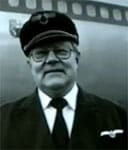Andreas Müller / University of Würzburg and German Aviation Office Cooperate on UAP-Reporting Center for Pilots
Translation by Andreas Müller, GreWi.de, original article published in GreWi.
THIS ARTICLE IS REPUBLISHED HERE WITH AUTHORIZATION AND CANNOT BE REPRODUCED WITHOUT THE AGREEMENT OF THE AUTHOR. A German version of this article can be found here.
Würzburg (Germany) – The Interdisciplinary Research Center for Extraterrestrial Studies at the University of Wuerzburg (IFEX) and the German Federal Aviation Office (Luftfahrt-Bundesamt, LBA) are now cooperating in the investigation of unusual aerial phenomena. Pilots will be able to report such sightings directly to IFEX via a new online reporting system.
There are numerous reports from pilots who have observed unidentified flying objects or strange light or atmospheric phenomena during flight. In scientific terminology, these are classified under the broader term “Unidentified Anomalous Phenomena” (UAP)—a new definition that extends beyond the previously common term UFO (Unidentified Flying Object).
UFOs or UAPs have become a global field of research. Despite many credible sightings, much about the nature and origin of these phenomena remains unknown. “Systematic investigations are crucial for collecting reliable data, analyzing it scientifically, and deriving well-founded insights,” says Hakan Kayal, Professor of Aerospace Engineering and head of the Interdisciplinary Research Center for Extraterrestrial Studies (IFEX) at the University of Würzburg.
UFO- and UAP-Sightings by Pilots
Sightings of unknown aerial objects have been part of manned aviation since its early days. One of the earliest known sightings occurred on January 31, 1916, when Lieutenant Morgan of the Royal Flying Corps observed an object with illuminated windows at an altitude of around 1500 meters over Rochford (Essex, UK). When he attempted to approach the object, his engine failed, and as he fired at it, the object abruptly shot upward and disappeared from view.
German pilots have also reported UFO sightings early on and continue to do so today. The most well-known reports likely come from Werner Utter (1921–2006). Utter was one of the first Lufthansa pilots to be licensed as a captain after World War II, served as chief pilot of Lufthansa from 1972 to 1980, and was responsible for flight operations on the board of the airline from 1972 to 1985. After his retirement, he spoke publicly about multiple UFO sightings during his career.
Utter’s first UFO sighting occurred in the 1950s:
On a flight from Beirut to Baghdad, as we were at around 3,000 meters altitude and had crossed over Lebanon, I suddenly saw a light in the starry sky, like a flare. This light kept coming closer, so I anxiously turned on the landing lights, thinking another aircraft was heading towards us. Suddenly, a huge fireball appeared next to the cockpit and inner engine, about five meters in diameter. It was a warm, reddish light. The entire fireball was moving. I wasn’t afraid at all. I was completely captivated by this light phenomenon. I looked at my co-pilot—he nodded, he saw it too; the cockpit was brightly illuminated. When I looked again, the light shot up into the sky at tremendous speed—and we were once again under the stars.
IFEX Reporting Center for UAP/UFO-sightings by Pilots
IFEX is dedicated to the scientific investigation of UAPs. To generate new knowledge in this field, the research center has recently launched its own online reporting portal, where pilots can report unusual sightings.
The IFEX reporting form is directly addressed to pilots:
As a pilot, you are professionally trained to observe the sky attentively. Your experience, expertise, and precise perception make your observations especially valuable for research. By submitting a report, you contribute to a better understanding of the phenomenon and help close existing data gaps. We are aware that UAP sightings have often been stigmatized in the past. Our goal is to provide a professional and scientifically grounded platform that encourages pilots to share their observations without hesitation. Every report helps us study the subject factually and based on data, and thus contributes to a more objective understanding.”
Pilot Sightings in the USA
Also in the United States, where aside of civil research organizations like the „Scientific Coalition for UAP Studies (SCU)“ or „Americans for Safe Aerospace“ the “All-domain Anomaly Resolution Office” (AARO) now investigates UFO/UAP sightings by government, military, and intelligence personnel on behalf of the Pentagon, pilot sightings are no longer ridiculed. They are taken seriously—particularly for reasons of national and aviation security.
Several videos recorded by U.S. Navy pilots—now declassified and confirmed as authentic by the U.S. Department of Defense—show flying objects whose characteristics contradict those of known aircraft and remain officially classified as „unidentified.“
One of the most famous sightings by U.S. Navy pilots occurred in 2004 off the coast of California (see video above, “FLIR1”). One of the witnesses was Lieutenant Commander Alex Dietrich, who described her sighting in detail in the following video interview with the American Veterans Center:
German FAA supports UAP Reporting Center for Pilots
The German Federal Aviation Office supports this approach and will include a link to the IFEX reporting form on its website under the “Occurence Reports” section:
Hakan Kayal also announced that the IFEX team plans to expand the reporting form further over time. Among other improvements, it will be integrated into a database and will allow uploads of images and videos.
– Direct link to IFEX reporting form for pilot sightings
– Direct link to the ENGLISH version of IFEX‘ UAP Reporting Center for Pilots






